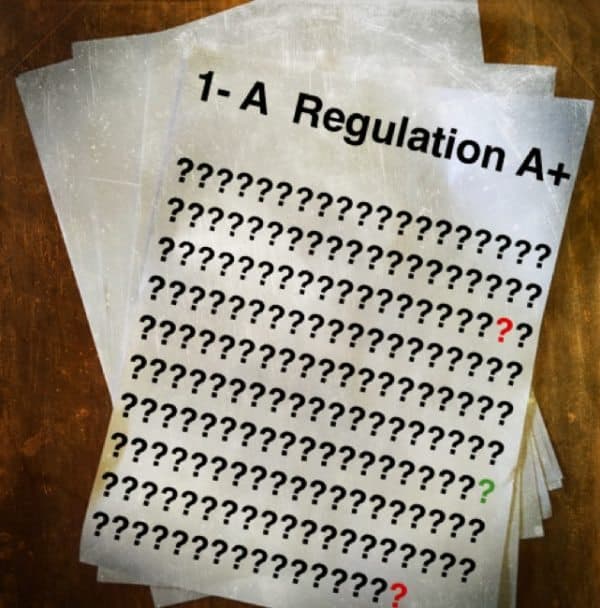If your company is not public and plans to raise capital, you might have considered Regulation A Plus – and you are aware that it comes with a big warning sticker: the company needs to prepare an offering circular and go through an SEC approval process. That sounds intimidating, and at the mere mention of this requirement many companies that could benefit from the new regulation give up without knowing what the process actually entails.
 The newly revamped Regulation A – commonly referred to as “Regulation A Plus” – has plenty to offer. It offers distinct advantages over private placements – in particular, the offering can be advertised and the pool of investors is not limited to wealthy “accredited investors.” The regulation also allows the issuer to raise up to $50 million without becoming a public company or doing a full-blown public offering – and it can raise up to $20 million without preparing audited financial statements or taking on any ongoing reporting burdens.
The newly revamped Regulation A – commonly referred to as “Regulation A Plus” – has plenty to offer. It offers distinct advantages over private placements – in particular, the offering can be advertised and the pool of investors is not limited to wealthy “accredited investors.” The regulation also allows the issuer to raise up to $50 million without becoming a public company or doing a full-blown public offering – and it can raise up to $20 million without preparing audited financial statements or taking on any ongoing reporting burdens.
For those committed to going forward with a Regulation A offering, as well as those still weighing the pros and cons, this article will walk through the required contents of the offering circular. In the regulation, the term “offering statement” refers to the entire submission on Form 1A, including the exhibits, while “offering circular” refers only to the narrative portion provided in Part II of the offering statement, which will be circulated to potential investors. The terms roughly correspond to the terms “registration statement” and “prospectus” in a registered public offering.
 The SEC will review the offering statement, including the offering circular, and the offering will not proceed until the SEC staff issues a qualification order on the offering statement. Issuers seeking to minimize delays from SEC staff comments will obtain advice from a securities attorney with significant experience working with the staff on disclosure issues. Such an expert can help the issuer anticipate the questions and concerns raised by the draft offering circular, and avoid the type of vague and formulaic language that raises suspicions of incomplete or evasive disclosures.
The SEC will review the offering statement, including the offering circular, and the offering will not proceed until the SEC staff issues a qualification order on the offering statement. Issuers seeking to minimize delays from SEC staff comments will obtain advice from a securities attorney with significant experience working with the staff on disclosure issues. Such an expert can help the issuer anticipate the questions and concerns raised by the draft offering circular, and avoid the type of vague and formulaic language that raises suspicions of incomplete or evasive disclosures.
Critical Contents: Summary and MD&A
 The summary of the offering circular is critical. While Form 1-A makes the summary optional, this may be the only part of the document that some investors will fully read. Issuers will want to use this opportunity to give a capsule description of the business proposition. Moreover, if it has no summary, the offering circular will begin with the risk factors, setting a negative tone. Be warned that the SEC staff generally insists that an offering summary be very brief – no more than a page if possible – and that it truly summarizes and does not repeat the information found later in the document. Think of the summary as the company’s “elevator pitch” – the best chance to capture an investor’s short attention span. Rather than a nebulous mission statement, the summary should say in a few sentences how the issuer expects to make money for investors and how it expects to make money better than its competitors.
The summary of the offering circular is critical. While Form 1-A makes the summary optional, this may be the only part of the document that some investors will fully read. Issuers will want to use this opportunity to give a capsule description of the business proposition. Moreover, if it has no summary, the offering circular will begin with the risk factors, setting a negative tone. Be warned that the SEC staff generally insists that an offering summary be very brief – no more than a page if possible – and that it truly summarizes and does not repeat the information found later in the document. Think of the summary as the company’s “elevator pitch” – the best chance to capture an investor’s short attention span. Rather than a nebulous mission statement, the summary should say in a few sentences how the issuer expects to make money for investors and how it expects to make money better than its competitors.
For most potential Regulation A offerors, the most unfamiliar part of the offering circular will be “management’s discussion and analysis of financial condition and results of operations,” usually referred to as “the MD&A.” The offering circular must include an MD&A that gives insight into the general development of the company’s business from the point of view of management, including the underlying causes for the historical changes in the key metrics shown in the selected financial table and all material trends and uncertainties identified by management. In addition, companies that have not had revenue for three years must provide a plan of operations for the 12 months following the offering, including plans for other financing.
Drafting the summary and the MD&A, and vetting them with advisors, will absorb a disproportionate amount of the total time spent on the offering circular, and senior management should participate fully in getting these sections right.
Plain English?
Regulation A continues to require that the information in an offering circular “must be presented in a clear, concise and understandable manner… Repetition of information should be avoided; cross-referencing of information within the document is permitted.” However, in amending Regulation A the SEC did not prescribe specific “Plain English” standards like those applicable to prospectuses under Regulation C, such as the avoidance of defined terms, the use of the active voice, bullet lists and graphics, and the avoidance of jargon. Of the recently submitted offering statements available on the SEC’s EDGAR database, some resemble “Plain English” prospectuses, while others have the type of dense, repetitive and legalistic language not seen in registered offerings for more than a decade. It is unclear whether the SEC staff will comment on the clarity of presentation in offering circulars. Nevertheless, preparers of offering circulars seeking to produce clear, concise and understandable documents would be well advised to read the SEC’s Plain English Handbook and to read recent prospectuses that carefully follow the standard. Plain English has become a “best practice” for disclosure documents in general, and offering circulars that follow the standard will more likely meet the SEC staff’s expectations for professionally prepared disclosure documents.
Contents of the Regulation A Offering Circular
Form 1-A includes a list of detailed items to be provided in the offering circular, which amount to a stripped-down version of an IPO prospectus. Regulation A issuers can also elect to provide an offering circular in the form provided in Part I of Form S-1 – which is the form actually used for an IPO prospectus. Real estate investment trusts (“REITs”) and similar real estate companies can provide an offering circular in the form provided in Part I of SEC Form S 11 – which is the form a REIT would use for an IPO. But most Regulation A issuers will likely prefer to use the simpler format included in Form 1-A.
The preparer of an offering circular will need to closely follow the instructions in Form 1-A for the following disclosure items:
- A cover page with the issuer’s name, basic offering information including commissions and net proceeds, names of underwriters, applicable state legends and a cross reference to the page where the risk factor section begins.
- A summary of the offering circular. This is the most important place to make the case that the company deserves the investor’s money.
- Risk factors. Form 1-A requires that risk factors be “carefully organized,” “short,” “concise” and have an “appropriate caption.” The caption for a risk factor should be a sentence that states the risk, not merely a label like “environmental risk.” Risk factors that are repetitive, that state risks affecting all business (e.g., “we will face competition”) and risk factors that state very remote risks will likely draw comments from the SEC staff.
- Dilution. In an offering of equity securities, if the price per unit paid by officers, directors and promoters in the preceding year was significantly less than the price investors will pay in the offering, the offering circular must disclose and describe the resulting dilution that investors in the offering will experience immediately on their purchase. A table is usually the best method of disclosing dilution.
- Plan of Distribution. The offering circular should describe any underwriting arrangements for the offering – or the absence of underwriters – along with compensation to be paid to underwriters. The offering circular should also describe the intended plans for marketing, selling and distributing the securities.
- Selling Securityholders. If existing holders will sell some or all of their securities in the offering, their identities and the number of shares offered by each must be provided in a table.
- Use of Proceeds to Issuer. This section should state the net proceeds – net of commissions and offering expenses – and explain how the issuer intends to spend them.
- Business. A description of the development of the offeror’s business over the preceding three years, or since inception if shorter. Form I-A prompts for specific types of information, but this section should also include a comprehensive and balanced description of all material information about the company’s business.
- Property. A description of the company’s facilities, including both owned and leased real property.
- MD&A. Through the eyes of management, a discussion of the company’s results of operations, liquidity and capital resources, as well as all material trends identified by management and a plan of operations for companies with less than three years of revenue.
- Directors, executive officers and significant employees. A table listing these persons, with their previous five years of business experience, disclosure of family relationships among them, and disclosure of involvement in bankruptcies or crimes in the preceding five years.
- Compensation of Directors and Executive Officers. A summary compensation table showing, for the last completed fiscal year, total compensation paid to the three highest paid officers or directors, and total compensation to directors as a group. For Tier Two offerings, data for the three highest paid officers or directors is broken down by individuals; for Tier One offerings data for all three may be aggregated.
- Securities ownership. A table providing information about the owners of the issuer’s voting securities. Like public company registration statements and reports, ownership is calculated in accordance with rules intended to show who exercises ultimate voting control over the issuer.
- Interest of management and others in certain transactions. Disclosure of related party transactions – material transactions between issuer and its officers, directors and their family members.
- Securities being offered. A description of the material terms of the securities being offered. For common stock, this will be brief. For preferred stock, debt securities, convertible securities and interests in limited partnerships and limited liability companies this section will contain important details.
Caution – Special Rules for Oil and Gas and Other Industries
The SEC rules include a set of “Industry Guides” which provide additional mandatory disclosures in the following specific industries:
- Bank holding companies
- Oil and gas programs
- Real estate limited partnerships
- Property casualty insurance underwriters
- Mining operations
Form 1-A requires any offering that falls within the definitions of these industries to provide the additional disclosures described in the Industry Guides. The additional disclosures generally relate to financial measures, regulatory issues and other facts that have special significance for investors in the relevant industry.
Limited Partnerships and LLCs
Form 1-A requires an issuer organized as a limited partnership or limited liability company to provide additional disclosures about the control, governance and taxation issues that affect investors in these non-corporate forms of business organization.
1 However, if the issuer wants to override state “blue sky” laws, it will need to have audited financial statements and file reports after the offering, even if offering $20 million or less.
2 Rule 253(d)(1) of Regulation A; see also former Rule 253(b).
3 See Rule 421 of Regulation C, 7 CFR 230.421.
(Editors Note: This is the 2nd article by the authors as part of a series on Regulation A+. The first article was entitled: Legal: Drafting the Regulation A Offering Statement
 As corporate and securities counsel at Homeier & Law P.C., Charles Kaufman advises companies in commercial and financial transactions, with an emphasis on raising capital through both established techniques and newly emerging ones like crowdfunding. He also counsels public companies on disclosure and compliance matters, especially those who want their reports and offering documents to communicate effectively with investors rather than merely sedating them. He has helped his clients to create, finance, govern, expand across borders, combine and exit their businesses, and to form strategic alliances, across a broad range of industries, including medical devices, healthcare, software, nanotechnology, film and music production, garment manufacturing, retailing, real estate investment and semiconductors. Charles earned both his J.D. and B.A. degrees at the University of California at Los Angeles. He is a member of the State Bar of California and serves on the editorial board of its International Law Journal.
As corporate and securities counsel at Homeier & Law P.C., Charles Kaufman advises companies in commercial and financial transactions, with an emphasis on raising capital through both established techniques and newly emerging ones like crowdfunding. He also counsels public companies on disclosure and compliance matters, especially those who want their reports and offering documents to communicate effectively with investors rather than merely sedating them. He has helped his clients to create, finance, govern, expand across borders, combine and exit their businesses, and to form strategic alliances, across a broad range of industries, including medical devices, healthcare, software, nanotechnology, film and music production, garment manufacturing, retailing, real estate investment and semiconductors. Charles earned both his J.D. and B.A. degrees at the University of California at Los Angeles. He is a member of the State Bar of California and serves on the editorial board of its International Law Journal.
 Jor Law is a co-founder of Homeier & Law, P.C., where he practices corporate and securities law, including helping companies take advantage of alternative forms of capital raising such as Regulation D, Rule 506(c) offerings and crowdfunding. He is also a co-founder of VerifyInvestor.com the resource for accredited investor verifications trusted by broker-dealers, law firms, companies, and investors who insist on safety and reliability.
Jor Law is a co-founder of Homeier & Law, P.C., where he practices corporate and securities law, including helping companies take advantage of alternative forms of capital raising such as Regulation D, Rule 506(c) offerings and crowdfunding. He is also a co-founder of VerifyInvestor.com the resource for accredited investor verifications trusted by broker-dealers, law firms, companies, and investors who insist on safety and reliability.


